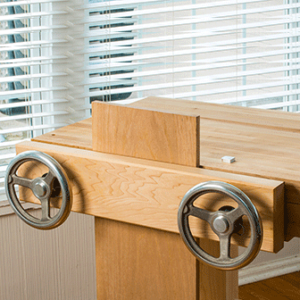History of the Face Vise
The face vise (bench vise) began to replace the leg vise because of the need to adjust the peg in the beam and the narrow width of the jaw. A typical wooden face vise utilized a wooden screw placed in the center of the jaw and had wooden runners placed on either side of the screw. The runners would help limit racking and prevent sagging when the vise was extended. A variation of the single screw face vise was the twin screw vise which was characterized by having two widely spaced wooden screws placed in the jaw. This created space between the screws to allow clamping wide boards on end.
Early twin screw face vises were probably mounted on top of the bench top as an appliance to temporarily allow clamping wide boards as shown in Joseph Moxon’s Mechanick Exercises (London 1703). When the twin screw face vise made its way to America it became an integral part of the workbench and was placed at the left front face of the bench. The twin screws were threaded directly into the bench top. A good example of this can be found at the Dominy workshop in East Hampton.
The biggest issue with the single screw face vise (bench vise) is that the center portion of the vise is occupied by the screw and runners preventing drop through clamping. The twin screw vise solved this problem but required the arduous operation of two un-connected screws to clamp something. Later versions of twin screw vises incorporated a chain and sprocket to allow clamping by rotating only one handle. This eliminated the necessity of having a third arm but synchronizing the two handles is difficult.
Advantages of Face Vise
The biggest advantage to the face vise (bench vise) is the ability to clamp long work on end. The greater width of the face vise jaw makes it ideal for clamping longer work horizontally to allow the long edges to be worked. The twin handle face vise is ideally suited to dovetailing wider boards because it allows drop through clamping. It is also ideal for clamping boards horizontally although it’s rather shallow throat (throat is the dimension from the bench top to the vise screw) may position wider boards up to high to work effectively.
Disadvantages of Face Vise
The most common complaint about face vises (bench vise) is racking when clamping work that is not centered in the vise. Shims may be used to create even clamping pressure but this is an inconvenient solution at best. Another complaint about face vises is the metal screw requires grease for ease of operation which can soil the work piece and they require considerable cranking for gross adjustments.
The VX20F Face Vise
The Hovarter Custom face vise mechanism is the only quick action twin shaft mechanism on the market. It utilizes hardened steel smooth clamp shafts instead of threaded rods like other twin screw vise hardware. The smooth clamp shafts do not require oil or grease for lubrication and won’t soil your beautiful work. When unclamped the vise jaw may quickly and effortlessly be slid in and out to suit the width of the work that needs to be clamped. Once the vise jaw is placed against the work one handle is rotated to clamp the work. You can apply as much or as little force just like a traditional screw. Clamping pressure is applied evenly no matter where the work is placed – no racking.
Installation of the VX20F could not be simpler. Just mount the vise mechanism under the bench top, install bearings in the rear jaw and install the vise jaw and handles. The VX20F can be outfitted with a single metal hand wheel, two hand wheels or a more traditional wooden hub and tommy bar style handle either singly or in tandem. You may also construct a handle of your own design to really give your vise and work bench the total custom treatment.
The VX20F face vise is not only quick action it also features quick removal. By simply removing a quick release pin the entire vise jaw may be removed and the clamp shafts retracted flush with rear jaw. This feature may come in handy if you need to clamp a large door or other large panel to the front of the bench. You can also create special clamping jaws to handle special situations in your shop such as clamping tapered legs or round work.

